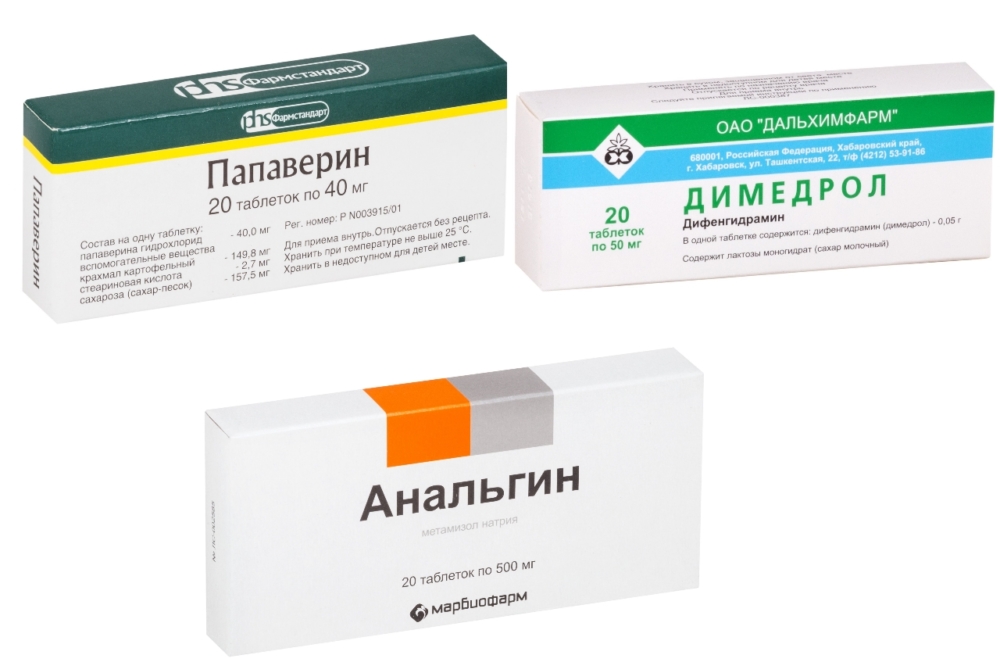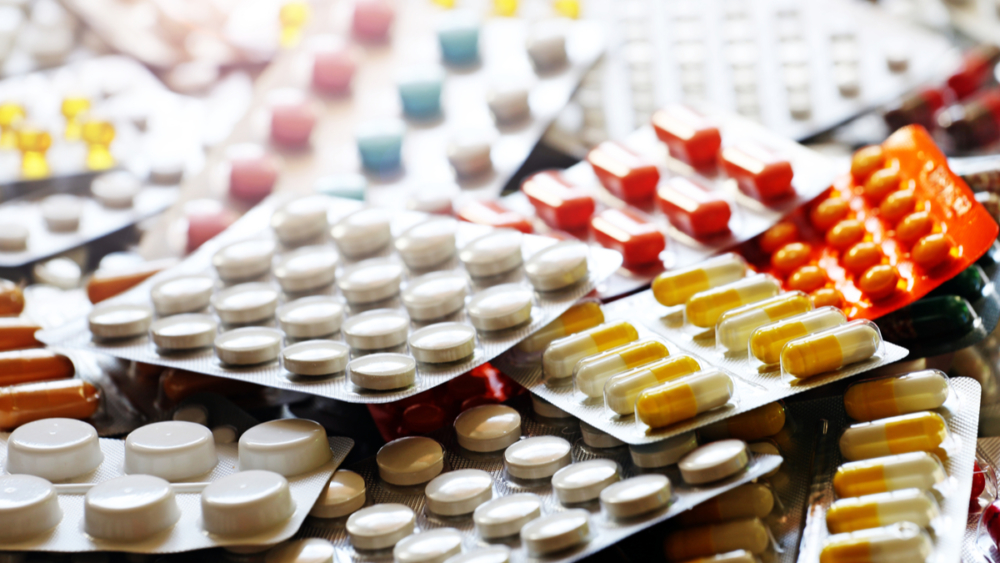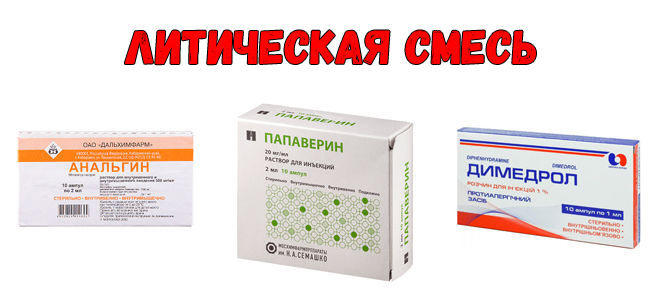For urgent relief of fever, a combination of Analgin, Diphenhydramine and Papaverine may be used. Doctors use it to quickly lower body temperature and alleviate the patient's condition. But this scheme can be repeated independently at home, if you know the principles of calculating the dosage.
Material Content:
- 1 Medicines that are part of the lytic mixture
- 2 What helps the combination of Analgin, Diphenhydramine and Papaverine
- 3 Dosage, proportions for children and adults
- 4 Drug interaction
- 5 Use of triad during pregnancy and lactation
- 6 Contraindications, side effects and overdose
- 7 How to replace a particular drug
Medicines that are part of the lytic mixture
This combination of drugs includes 3 components. Contains triad Analgin, Diphenhydramine and Papaverine. Each of them is responsible for its action:
- Analgin (sodium metamizole) - a 50% solution is taken, which is responsible for relieving pain.
- Diphenhydramine (diphenhydramine) is an antihistamine whose action is aimed at relieving allergic manifestations.
- Papaverine - is produced in the form of hydrochloride, acts as an antispasmodic, as a result of which the vessels of the skin expand, which increases the level of heat transfer and provides an antipyretic effect.
Due to the rapid decrease in body temperature, the development of convulsive syndrome is prevented. This is especially important for young children. Their fever can lead to serious consequences.
What helps the combination of Analgin, Diphenhydramine and Papaverine
Use an injection of triad from temperature. But the lytic mixture cannot be used constantly, it is administered only in emergency cases. First, they try to bring down the fever with monocomponent antipyretic drugs (Nurofen, Panadol, Paracetamol).If this fails, they will move on to stronger measures.
Attention! To bring down the temperature for children and adults is only 38.5 ° C.
Up to this point, fever is not considered life threatening. It only shows an adequate response of the body to the penetration of pathogenic microbes. But if the child has a tendency to develop seizures, the lytic mixture can be administered at lower marks on the thermometer.
You can not use the triad from the temperature every time a fever occurs. This is due to the strong effect of the drugs that make up its composition. With constant use, the body develops resistance to the action of other means, and the ability to independently regulate body temperature also disappears.
Dosage, proportions for children and adults
In the injection of Papaverine, Analgin and Diphenhydramine, the dosage of each component is calculated separately. It is different for children and adults and is selected according to the weight of the patient. For a child, the amount of drugs also depends on age:
- up to a year - Analgin: 10 mg per kg of body weight, diphenhydramine - 0.1 ml, papaverine - 0.1 ml;
- after a year - all three components are taken from the calculation of 0.1 ml, multiplied by the age of the child (only full years are considered).
An injection is not always possible, so in some cases it is permissible to replace it with tablets. But you can use this scheme only after reaching 3 years. To do this, you will need:
- 1/3 diphenhydramine;
- ¼ Analgin;
- ¼ Papaverine.
The tablets need to be crushed into powder, and then dissolved in a spoon of water. The resulting mixture is given to the child to drink. The therapeutic effect appears after 20-30 minutes, but lasts the same time as after the injection of the triad.
For children from 15 years of age and older, as well as for adult patients weighing more than 60 kg, 2 ml of Analgin and Papaverine will be required, and 1 ml of Diphenhydramine should be taken. With a higher body weight, for every 10 kg, 1/10 of this dosage is added. All drugs are collected in one syringe and injected intramuscularly.
The maximum number of injections of the lytic mixture per day is 4. Exceeding this dosage can cause side effects. With frequent use, sensitivity to drugs decreases, which will require an increase in dosage.
Drug interaction
Preparations of the lytic mixture interact with each other, mutually enhancing therapeutic effects. But they can affect the means of other groups. In the complex treatment of diseases, it is worth considering:
- Analgin with non-narcotic type analgesics, oral contraceptives, tricyclic antidepressants and allopurinol becomes more toxic, therefore they are not taken at the same time;
- the effect of Analgin increases with concomitant use with anxiolytics and sedatives;
- barbiturates increase the antispasmodic activity of Papaverine, and also reduce the effect of Analgin;
- hypoglycemic agents for oral administration, metamizole, glucocorticosteroids, indirect-type anticoagulants and indomethacin act stronger in combination with Analgin;
- reserpine, antidepressants of the tricyclic structure, quinidine and procainamide increase the effect of lowering the pressure from Papaverine;
- ethanol in combination with analgin acts stronger;
- cyclosporine is more rapidly excreted from the body when combined with analgin;
- cannot be used together with the lytic mixture and several hours after it penicillin, X-ray contrast preparations and colloid-type blood substitutes;
- with the combination of Analgin with sarcolysin and tiamazole, the chance of lowering the number of leukocytes in the serum increases.
When using a lytic mixture in conjunction with other agents, it is worth considering all possible drug interactions. In some cases, it is required to recount the proportions of the drugs. This will help prevent complications and provide an optimal therapeutic effect.
Use of triad during pregnancy and lactation
Use Analgin during the period of feeding the child is unacceptable. If mother had to introduce a lytic mixture, milk should be decanted 1 time. Further, the restoration of breastfeeding is possible.
When carrying a child, do not use Analgin. It is especially dangerous in the early and late stages. In mid-pregnancy, use is possible under the supervision of a physician.
Contraindications, side effects and overdose
The lytic mixture refers to potent agents. Therefore, it has a list of contraindications:
- hyperreactivity to one of the components or substances similar in structure;
- acute abdominal pain (until appendicitis is excluded);
- asthma of bronchial origin and during treatment with NSAIDs;
- severe violations of the liver;
- blood pathology, including hemolytic anemia;
- glaucoma;
- breastfeeding time;
- bronchospasm;
- blockade of the anti-ventricular type;
- the period of bearing a child (early and late).
In some cases, under the influence of the lytic mixture, side effects develop. These include:
- drop in blood pressure;
- reddish urine due to the breakdown products of Analgin;
- drowsiness.
Most of the unpleasant symptoms from using one drug are blocked by the therapeutic effect of another. Therefore, their total amount for the lytic mixture is small. In order to avoid overdose, the triad is not used earlier than 4 hours after the administration of the drug from its composition. If the amount of the injected mixture is too large, the patient will develop severe drowsiness. Symptoms go away on their own and usually do not require medical attention.
How to replace a particular drug
Baralgin has a similar effect to Analgin. It is available in the form of tablets and ampoules for injection. It is used not only as a component of the lytic mixture, but also as a remedy for menalgia and headaches.
Diphenhydramine is considered an obsolete drug. Use it for children is not recommended. Therefore, the medicine is replaced by Suprastin or Tavegil. The severity of side effects is less, and the effectiveness is higher.
Instead of papaverine, drotaverin or no-shpu can be used to relieve vasospasm. Their actions are similar, and contraindications are almost identical. Therefore, use the tool that is in the medicine cabinet at the time of the disease.
The lithium mixture has been used for many years as an effective remedy for high temperature. It is used for patients of any age. It is important to correctly calculate the dosage in order to ensure the optimal therapeutic effect without the development of side effects.


















